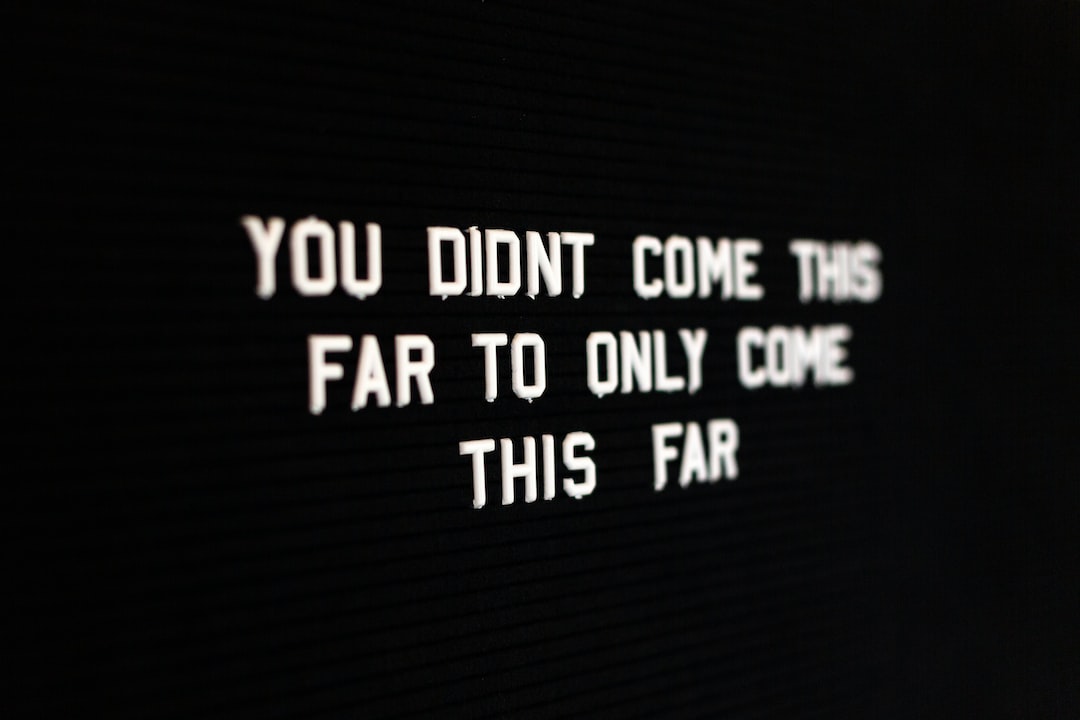How to set SMART goals: A step-by-step guide with examples and templates
How to set SMART goals: A step-by-step guide with examples and templates
1. Introduction
A goal is a desired result or intended outcome that a person or a group of people commits to achieve. Goals can be short-term, such as getting a job or saving money for a car; or long-term, such as getting a degree or becoming a millionaire.
No matter what kind of goal you have, setting and achieving it can be a challenge. This is where the SMART goal setting method comes in. SMART is an acronym that stands for Specific, Measurable, Achievable, Relevant, and Timely.
If you’re looking for a step-by-step guide on how to set SMART goals, with examples and templates, then you’ve come to the right place. Keep reading to learn everything you need to know about setting SMART goals!
https://unsplash.com/@sako_sarah_koenig
2. Defining your goal
Once you’ve determined that a goal is SMART and achievable, you’re ready to define it. Defining your goal is an important step that can help you maintain focus, ensure that you’re on the right track, and make sure that you have all the resources you need to succeed.
When defining your goal, start by asking yourself the following questions:
- What do I want to accomplish?
- Why do I want to accomplish this goal?
- What resources do I need to achieve this goal?
- Who else needs to be involved in this goal?
- What will I do each day to work towards this goal?
- What milestones will I set to measure the progress of this goal?
Take some time to answer these questions and write down your answers. This will help you to come up with an action plan and set yourself up for success.
https://unsplash.com/@clarktibbs
- What is your goal?
Now that you’ve asked yourself these important questions and taken the time to answer them, it’s time to set your goal. Your goal should be specific, measurable, and achievable. To ensure that your goal meets these criteria, ask yourself the following questions:
- What will I do in order to reach this goal?
- How much time will I dedicate to achieving this goal?
- How will I ensure that I stay on track throughout the process?
- What challenges do I anticipate I might face?
- How can I overcome those challenges?
Once you’ve answered these questions, you should have a clear picture of what your goal is and how you can reach it. Once your goal is defined, you can create an action plan to keep yourself accountable and stay focused on achieving your goal.
https://unsplash.com/@srz
- What are your objectives?
Now that you’ve asked yourself the important questions and defined a goal, it’s time to set your objectives. Objectives help to break down your goal into smaller, more manageable chunks. Instead of focusing on one large, daunting task, you create intermediate objectives that will help you reach your main goal.
As you create your objectives, make sure that they are Specific, Measurable, Achievable, Relevant and Timely - or SMART. SMART objectives give you a plan of action breaking down your goal into smaller, more achievable steps that you can easily measure your progress.
For example, if your goal is to write a novel, your objectives might look something like this:
- Write 500 words a day
- Spend 1 hour every day researching and brainstorming
- Overcome writer’s block by talking to other writers
- Complete first draft by end of month
- Edit and revise draft within 6 weeks
Creating SMART objectives will help you maintain focus and stay on track as you work towards reaching your goal.
https://unsplash.com/@austinchan
- What are your personal and professional motivations?
Your personal and professional motivations can be a powerful source of drive that can help you reach your goal. When setting SMART goals, it’s important to define the personal and professional motivations that drive you.
By psychological categorization, motivation can be divided into two types – extrinsic and intrinsic. Extrinsic motivation is when you are incentivized to complete a task for external rewards such as money, awards, recognition and praise. Intrinsic motivation on the other hand is when you complete a task based on personal reasons such as interest, enjoyment or satisfaction.
In both cases, motivation acts as a key player in helping you progress towards completing your SMART goals. When setting your objectives, ask yourself how you can use both intrinsic and extrinsic motivation to help you reach your goals.
For example, if your goal is to write a novel, your motivations could be:
- Extrinsic – To publish a book, win an award, and/ or attract new clients
- Intrinsic – To satisfy your creative urges and fulfil your passion for writing
By having a clear understanding of your motivations, you can leverage it to push yourself when needed, channeling it into your work to drive yourself further towards achieving your goal.
https://unsplash.com/ko/@jontyson
3. Making your goal specific
SMART goal setting includes defining your goal in specific terms. This is important to ensure you have a clear understanding of what you want to achieve and how to get there.
To make your goal specific, use the following questions to help guide you:
1. Who is involved? – Is there anyone else that will help or be affected by your goal?
2. What do you want to accomplish? – Set a time frame and a clear desire to achieve the aim of your goal.
3. Where will it occur? – Set a location and set up any information you need to achieve your goal.
4. When do you want to achieve it? – Set a timeline or a specific date by when you want to achieve your goal.
5. Why do you want to achieve it? – Think about the motivations and purpose behind your goal.
By making your goal as specific as possible, you will be more likely to achieve it. Having clarity on the elements of your goal will help to keep you on track with your desired outcomes and ensure you focus on what you set out to do.
https://unsplash.com/@randalynhill
- What are your circumstances?
The key to setting SMART goals is to consider your current circumstances. You need to consider where you currently stand in terms of resources, willingness, finances and any other matters that can influence you in achieving your goals.
Your circumstances can change and your goal may become harder or easier to achieve. This is why it is important to review your circumstances and plan accordingly. It can be useful to write down the factors of your circumstances and how they can help or hinder your progress.
To help guide you in understanding your circumstances, use the following questions to help you:
1. What skills do you possess that can help you in achieving your goal?
2. Do you have any resources that may help you in achieving your goal?
3. What are the current costs associated with this goal?
4. Are there any external factors that might help or hinder your goal?
5. What do you need to do in order to move forward with your goal?
By understanding your current circumstances, you will be able to set realistic goals that are achievable. This will help you in staying motivated and focused on what you set out to achieve.
https://unsplash.com/@helloimnik
- Who is involved?
It is important to identify who is to be involved in achieving your goals, as this will help you set better SMART goals and create successful plans to reach those goals.
It can be helpful to identify who the stakeholders are. Stakeholders can include those who will have an influence or have an interest in the outcome of reaching your goals.
Your stakeholders can include people you know such as family, friends or colleagues. It could include people you don't know, such as customers, suppliers, suppliers of products and services, or even the press.
By taking into account who is involved with reaching your goals, you can take into account their different needs and interests when setting your SMART goals. You can then develop plans to involve and manage their interests throughout the process. This will ensure everyone is engaged and working together towards the same successful outcome.
https://unsplash.com/@dbeamer_jpg
- What are the details?
Once you have identified the stakeholders and come up with a SMART goal, it's time to flesh out the details.
What resources or skills do you need to achieve your goals?
What tasks need to be undertaken in order to reach your goal?
Who is responsible for taking on each task?
You should also consider what deadlines should be applied to each task. This helps to ensure the process is kept on track and can help to motivate team members to keep striving to reach the goal on time.
Not only this, you may need to consider any risk factors that could affect the goal and any actions needed to solve them if problems arise.
Breaking the goal down into smaller tasks also helps by allowing team members to measure progress as they work their way towards achieving the SMART goal. This can help to keep morale and motivation high.
By considering all of the details, you can create a clear plan of action to successfully reach your SMART goal.
https://unsplash.com/@nate_dumlao
4. Making your goal attainable
Now that you have set your goal, the next step is to make sure that it is achievable and realistic.
This starts with unpicking and restructuring the goal into smaller chunks. Smaller chunks are easier to tackle and makes it easier to measure progress.
The timeline should be achievable, as well as the budget. If the budget is unrealistic, consider whether you can source things cheaper, or investigate other external sources of funding.
The goal should also be measurable, so that you can track the progress and make adjustments along the way if needed.
Another way to make sure that the goal is achievable is to consult the team responsible for achieving it. They are the experts and will be the ones carrying out the tasks, so get their input to make sure that the goal is achievable and realistic.
By breaking down the goal and talking to the team, you can make sure the goal is achievable and realistic. This will be key in ensuring that the goal is met and the team are successful in its endeavor.
https://unsplash.com/@theblowup
- What resources do you have?
Once you have made sure that your goal is achievable and realistic, the next step is to examine the available resources. This is an important step for two main reasons. First, it allows you to assess how much time and money are needed to achieve the goal. Second, it is key in ensuring that the team is equipped with the necessary skillsets.
When assessing what resources you have available, start by looking internally. Are you able to reallocate resources or upskill existing employees to meet the goal? If not, are you able to bring in short-term contractors or hire new staff to work on the project?
For any external resources, such as funding or specialist resources, be sure to speak to the relevant departments or professionals to make sure that you have a robust plan of action.
By assessing the resources you have available and ensuring that the team is properly equipped, you will have a better chance of achieving the goal, and ensuring that the team have all the necessary resources to complete the task.
- What are your limitations?
Having a set of achievable and realistic goals as well as accessible resources is key for success. The next step in setting SMART goals is to understand the limitations that you may face.
Understanding the limitations can allow you to better plan your resources, as well as provide you with a realistic outlook. Different things can cause limitations to your plan, such as budget restrictions, time constraints, and the need for external stakeholder approval.
When assessing your limitations, it can be helpful to brainstorm any potential roadblocks and list the possible threats to success. This will help the team to be prepared for anything that may arise during the setting and achievement of the goal.
Some other ideas include: setting milestones for the goal which will allow for comprehensive tracking, scheduling checkpoints for the team to monitor their progress, and setting up a series of open dialogue channels to discuss any potential issues.
By understanding your limitations and putting reasonable measures in place, you will be able to adjust to any potential changes in approach that may occur over the course of attempting to achieve the goal.
- What risks are you willing to take?
The full success of setting SMART goals relies on the risks you are willing to take. It is important to assess the risks that you are likely to face and how you are going to handle them. This involves assessing the potential impact of each risk and developing strategies to minimise their effects.
Some of the risks related to goal setting that you should think about include:
- Unforeseen external conditions – Your plan may have to be adjusted if there are external factors that cannot be accounted for in the initial setting of SMART goals.
- Insufficient resources – If your team does not have the resources to achieve the goal, steps must be taken to address those issues.
- Poor performance – It may be necessary to reassess resources and skills to determine if it is feasible for the team to achieve the desired outcome.
The list of risks above is not exhaustive, but provides an overview of the issues you should consider. Identifying potential risks that you may face as you strive towards your goal is essential to ensure that these challenges can be overcome.
5. Making your goal relevant
Once you’ve identified any potential risks and made sure that your goal is SMART, it's time to make your goal relevant. To do this, ask yourself questions such as ‘who will benefit from me achieving this goal?’, ‘what impact will it have on my organisation?’ and ‘where does this goal fit into my personal and professional development?’
These questions are designed to help you establish the relevance of your goal and make sure that achieving it will have a lasting impact. Additionally, by identifying the stakeholders and individuals who may benefit from the goal’s achievement, you will have an easier time staying motivated throughout the goal setting process.
By thinking through these questions, you will ensure that your goal is an achievable and relevant one which will have a positive impact on both your short and long-term goals. Additionally, this process will also provide you with insight into potential risks or challenges which may arise, enabling you to be better prepared to tackle them.
- What is your timeframe?
Now that you have identified a goal that is relevant and SMART, it's time to set a timeline. This is when you decide when you want to achieve your goal by and how long it should take you. Your timeline should be realistic and reflect the amount of effort you are willing to put into achieving it.
When setting a timeline, consider the following questions:
- How much time do I have to dedicate to working on this goal?
- How complex is the goal and what potential barriers could arise that would slow down my progress?
- What resources and support do I have available to me?
By answering these questions, you will be able to set realistic expectations for yourself and clearly set out what needs to be done and by when. This will enable you to keep track of your progress and stay motivated throughout the process.
It's important to remember that no timeline is set in stone and you can adjust it if needed. Should you find that you are not making progress as quickly as you had anticipated, take the time to review what elements are taking longer than expected and consider extending your timeline. With this approach, you can ensure that you are making steady progress towards your goal without getting overwhelmed.
- What is your ultimate goal?
Now that you have identified your goal and set a timeline, it’s time to think about the ultimate result that you want to achieve. Your final goal should be measurable so that you can track your progress and make sure you are reaching your targets.
Your ultimate goal should incorporate the long-term objectives that you have set as well as any unique characteristics of your particular goal. For example, if you have set a goal to get fit you may want to focus on increasing your physical strength and endurance as well as your overall fitness levels.
By articulating your ultimate goal you will ensure that it is specific and achievable. This will enable you to focus your efforts and track your progress towards achieving the outcome you desire. Additionally, it will also give you something to celebrate when you have finally achieved it!
6. Making your goal time-bound
Once you’ve established the overall goal and a timeline for achieving it, you need to set specific and meaningful milestones to ensure you stay on track. Each milestone should be tied directly to the larger goal and reflect the progress that you plan to make.
It is important to set goals that are time-bound. This will help to keep you focused, organized and motivated to uphold your commitments and to monitor your progress. Additionally, setting a timeline will ensure that your goals are realistic, since it’s easy to get overwhelmed if you have a goal that’s too big or too ambitious.
Make sure that you set smaller, achievable goals for each milestone. Once you have made progress on the smaller goals, each milestone can be extended and refined. This iterative process will give you more specific results that can be monitored and optimized over time. It is also important to remember to make adjustments along the way – as necessary – to ensure that your goals remain realistic and achievable.
For any question, please contact us in OpenTimeClock.com. https://www.opentimeclock.com.
Created with the Personal Edition of HelpNDoc: Free EPub and documentation generator









